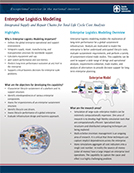
Integrated Supply and Repair Chains
Enterprise logistics modeling enables the exploration of long-term performance for a global sustainment infrastructure. Analysts are motivated to model the enterprise to better understand anticipated lifecycle costs, evaluate sustainment requirements, and perform a variety of sustainment-related trade studies. This capability can be used for a wide range of design and operational analyses, requirements validation, trade studies, and analysis of alternatives to provide decision support for long-term enterprise planning.
Why is Enterprise Logistic Modeling important?
- Defines the global enterprise operational and support environment
- Integrates supply, repair, manufacturing, and trasportation processes for worldwide support
- Calculates equipment and support system performance and cost metrics
- Predicts long-term performance outcomes at any level in the enterprise
- Supports critical business decisions for enterprise scale problems
What are the objectives for developing this capability?
- Characterize lifecycle sustainment of a platform and its support structure
- Identify interdependencies of various enterprise components
- Assess the responsiveness of an enterprise sustainment structure
- Identify lifecycle cost drivers
- Assess lifecycle performance of a global enterprise
- Evaluate infrastructure design and business rules
What are the research areas?
- Development of high-fidelity simulation tools that are computationally efficient
- Specialized data structures and distributed computing techniques
- Multi-echelon inventory management
- Capturing the impacts of diverse funding sources on enterprise-level operations
Fact Sheet

Click Fact Sheet to download PDF.